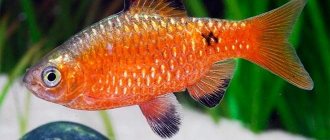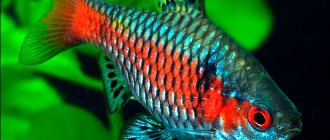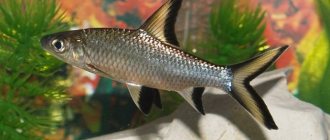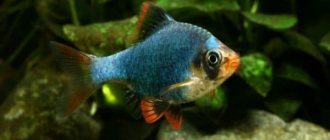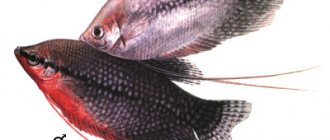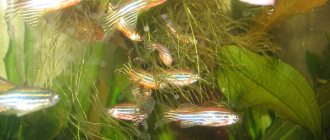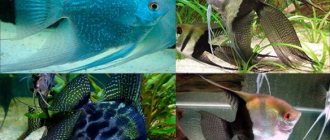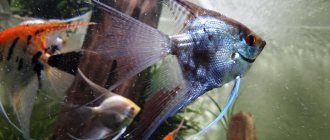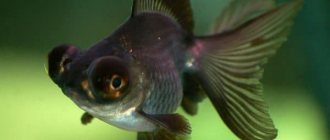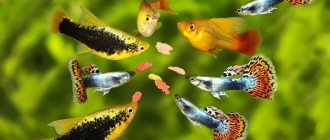At what age can gender be determined?
First of all, it should be noted that determining the sex of barbs is not an easy task, especially for non-professionals.
The fish reach sexual maturity at an average of 6-12 months. But primary differences between males and females can be observed as early as 3 months. By this age, the color of the males becomes brighter, and in some species distinctive features appear (for example, the color of the fins or tail).
Later, the fish begin to differentiate in size and behavior. The differences become most pronounced at the time of puberty. Then females can be recognized by their rounded abdomen and calmer behavior. Males often play or fight with each other, and also show attention to the “ladies.”
Barb species
The natural color of the barb is golden
The natural color of the barb is golden. Other shade variations are the result of artificial breeding. Two types of fish were obtained through selection:
- mossy barbs;
- albinos.
The difference between them is the color. The vertical stripes of mossy barbs are greenish in color. They also merge and cover the body of the fish almost completely. The vast majority of fry of such barbs (75%) inherit the color of their parents, the remaining 25% acquire the usual color.
Mossy barbs are usually green in color.
You can distinguish an albino by its pink body covered with red stripes. This is a rare species of barb because it is quite difficult to breed. It is extremely rare to get offspring from two albinos, so when breeding you have to use a regular barb. In this case, the number of albinos is only 25% of the total offspring.
Albino Barbus is a rather rare species, because... It's quite difficult to get it out
Main Differences
In the Sumatran variety
Males are smaller in size and have a flatter body.- Females have a rounded abdomen , which is especially noticeable on the eve of spawning.
- Males are brighter than females. Their nose, the edges of the dorsal and anal fins, as well as the edges of the tail are colored red, which becomes even more intense towards spawning.
- Male fish are more active and fight among themselves. If the aquarium contains smaller representatives of other species, the males may become aggressive. Barbs often bite off the fins of other fish.
At the mutant barbus
This fish is a direct “relative” of the Sumatran barb, so their sexual characteristics are approximately the same:
- Females are larger and have a convex abdomen.
- Males are more expressively colored . Their scales shimmer with a bright green color, and during spawning the nose becomes red.
- Males are more aggressive , they like to “fight” among themselves, although for them it is more of a game than a real fight.
Sexual characteristics appear at spawning. This happens at about 4 months, when the fish reach 3 cm in length.
The black one
- Females are larger and have a rounded abdomen.
- Male individuals are brighter ; during spawning, their black stripes merge, and the front part of the body turns ruby. In females, on the contrary, the stripes become more pronounced.
- Male black barbs love to stage demonstrations in front of the “ladies” : they fight, push, and bite. This behavior is aimed solely at attracting the attention of the opposite sex. As soon as the female swims away, the fighters immediately calm down.
At cherry
Females are larger than males and have a pronounced abdomen.
Male individuals are red in color, which turns bright cherry during spawning and excitement. Females are paler, their abdomen is cream-colored.
Males are characterized by rivalry, which is expressed by dancing in front of a competitor. It usually doesn't come to real fights.
And the tendency of fish to “sort things out” is used by aquarists, because at such moments cherry barbs acquire a particularly bright color.
Denison's
Sexual dimorphism in this species is very weak. You also need to keep in mind that in the entire history of fish breeding there have been few cases of successful reproduction in an aquarium. Usually only professionals in special nurseries succeed in this.
However, slight gender differences in Denison barbs can be observed:
- Females are slightly larger than males; on the eve of spawning, their abdomen is noticeably rounded.
- Females are more modestly colored , but 1-2 weeks before spawning they develop the so-called “nuptial plumage.” A yellow spot with blurred edges protrudes on the anal fin. A week later, a black spot resembling an eye appears in it.
- Males can be aggressive towards smaller fish. This can be avoided by keeping 6-10 barbs in one aquarium. In nature, fish always stay in a school, this allows them to feel calmer and more confident.
- Sometimes males can demonstrate rivalry with each other, but it is expressed rather weakly. As soon as the leader of the school is established, the fish again become calm and peaceful.
Thus, secondary sexual characteristics in barbs are not clearly expressed. But with the right information, everyone will be able to distinguish females from males by size, color and behavioral characteristics.
Description of the species
These schooling fish have a memorable color and appearance: a golden-yellow or silver body with tightly fitting gills intersected by black vertical stripes of medium width. The body of the Sumatran is quite high, slightly flattened laterally.
The back of the fish is painted in a darker color, having a reddish tint, and the belly is yellow-white. A characteristic feature of this species can be considered four vertical black stripes. The first one passes through the eye of the fish, the second - behind the pectoral fin, the third - behind the dorsal fin, the fourth - at the base of the tail.
We suggest you read: How to determine the size of a muzzle
The triangular-shaped dorsal fin is quite high, it is colored black with a thin red border. Other fins are red or pink. Small barbs, which reach seven centimeters when kept in an aquarium, live about four years with proper maintenance and proper nutrition, although cases of higher rates have been recorded. To keep a group of barbs you will need an aquarium with a volume of at least 30 liters.
Preparing for spawning
Preparation for spawning begins with the separation of females from males for a couple of weeks in a spawning aquarium. Fish should be fed primarily with live food, but herbal supplements are also welcome. If you have not made a mistake in determining the sex, then by the end of the second week the females’ tummy will increase significantly, and the anus may protrude. If such females are not spawned, this will lead to illness and even death.
The spawning aquarium should not be very large, 20-30 liters is enough. Take a third of the water from the barbs' permanent aquarium and add soft and sour (ph6.0) fresh water. Turn on a good, bright light. It is advisable to use aeration before the start of spawning, but then all equipment should be turned off. Only very weak aeration can be left. The temperature is raised 2-3 degrees above normal. Nets, mosses and even washcloths are used as daytime shelter =). The main thing is that producers cannot get their own caviar, otherwise it will be instantly eaten.
Spawning
A month before spawning, barbs are placed in separate tanks and the water is cooled a couple of degrees. You can also divide the aquarium using glass. It should have small holes for water circulation. Boys are given protein food, and girls are given vegetable food. The female's readiness to reproduce is determined by the swelling of her abdomen.
To achieve success in reproduction, the male must be 3-4 months older than the female.
When the barbs unite after being seated, the male begins to court the female. At the moment when the girl begins to spawn, he follows her and leaves the seed for fertilization. At one time, a female barb lays approximately one hundred eggs. Sometimes the number of eggs reaches six hundred.
It is best if the pair is placed in the aquarium for spawning in the evening. The container should be placed in such a place that the sun's rays do not fall on the eggs. If such a place cannot be found, you should darken the walls of the aquarium.
If you add salt to the water, fertilization will occur much better. For 10 liters it is enough to add one teaspoon.
If the fish stop spawning, they are removed from the aquarium, since adults often eat them. In order to prevent this, it is enough to place large pebbles on the bottom. The spawning process usually lasts about two hours.
After five days, the fry will hatch from the eggs and begin to swim. The water temperature should reach +26 C. They should be fed ciliates, rotifers, and other small food. At an older age, the fry are given small crustaceans. Young barbs are prone to cannibalism, so the fish should be periodically sorted by size and separated.
Young individuals are capable of reproduction at eight to ten months.
In a common aquarium
Barbs also spawn successfully in a community aquarium. In order for this process to have a positive result, it is enough to provide future fry with the following conditions:
- soft water;
- vegetation on the bottom (fry must have shelter);
- the presence of ciliates and other similar small creatures in the water.
In such conditions, most of the young animals will be able to survive and grow.
If you manage to catch the moment when a barb gives birth in a common aquarium, then the eggs can be carefully collected and placed in a separate tank. To care for the fry, it is not necessary to immediately purchase a separate aquarium. At first, an ordinary food container, a plastic bottle or a three-liter jar will be enough.
Spawning tank
To breed barbs, you must choose an aquarium with a volume of at least 20 liters. Since representatives of this species prefer partial shade, the container for their maintenance is planted with a large number of plants with large leaves. It is also necessary to put moss and spawning panicles.
Barbs do not care about their offspring, which means that the young must be provided with the necessary protection, or a place where the fry can hide.
Representatives of this species feel comfortable at a temperature of +23 - +25 C. For successful spawning, the water temperature in the aquarium is raised to +26-+28 C.
What you need to consider for arranging a spawning area:
- before the mating season, females are kept separately from males;
- fish must eat well;
- in the spawning aquarium the water level should reach 15 cm;
- to fill the container you need to take half fresh water and half from the general aquarium;
- there should be no soil at the bottom of the spawning tank;
- if you place a fine mesh net or moss at the bottom of the spawning tank, the parents will not be able to eat the eggs;
- At the bottom of the spawning tank you need to place plants with small leaves and press them down with pebbles so that they do not float to the surface.
Spawning of Sumatran barbs
Lovers are united in the evening so that by morning they will have spawned. It is believed that if this does not happen within a couple of days, the fish are seated. There was probably an error in choosing the male and he should be replaced. Or maybe you even cross females with females?
